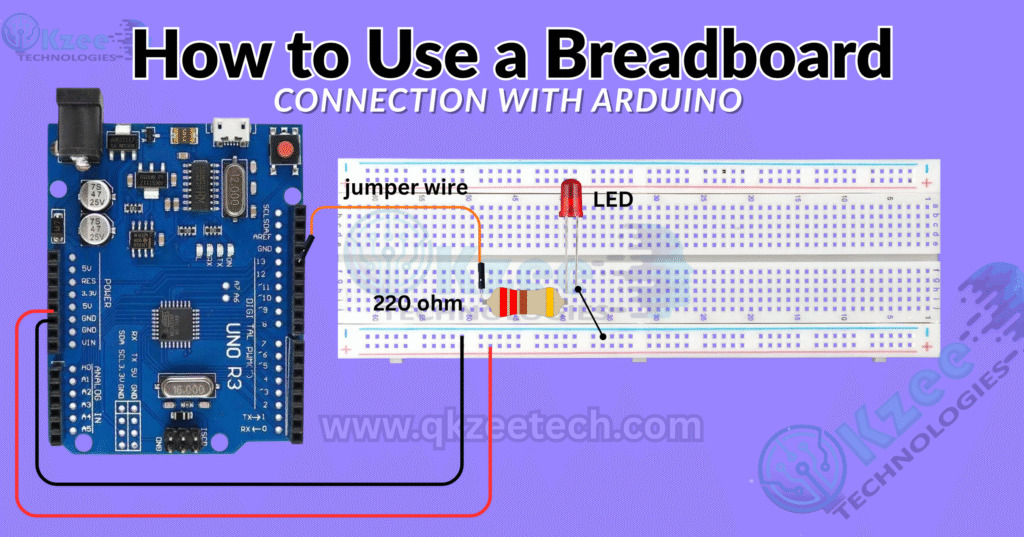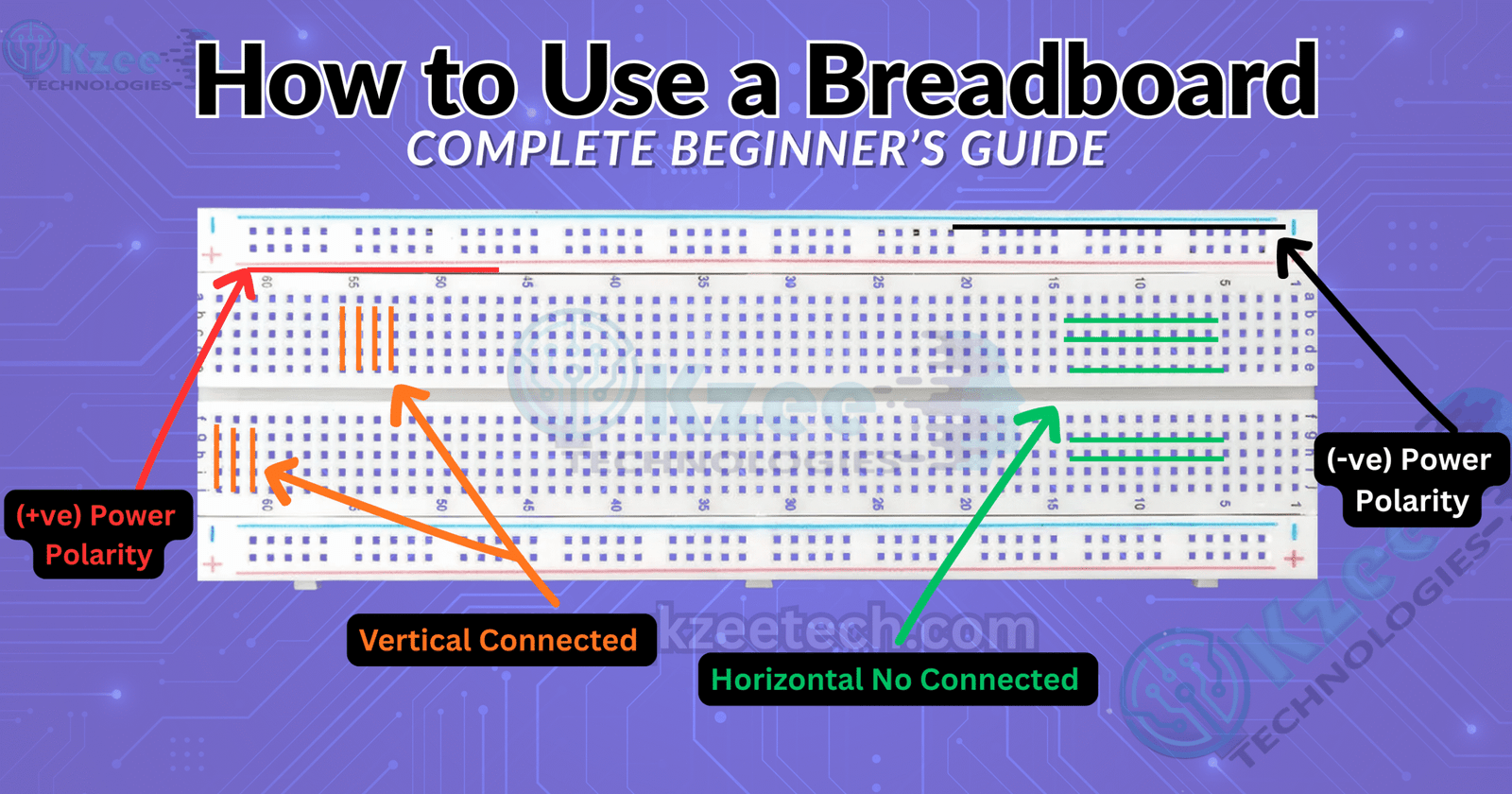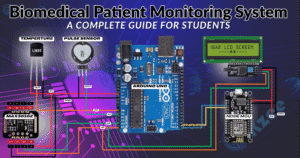How to Use a Breadboard – Complete Beginner’s Guide
How to Use a Breadboard – Complete Beginner’s Guide
Introduction – What Is a Breadboard and Why It’s Essential
A breadboard is one of the most important tools for anyone learning electronics engineering or working on students projects and final year projects in Lahore. It allows you to build and test electronic circuits without soldering. Think of it as a reusable platform for DIY projects, Arduino projects, and IoT systems.
Whether you’re buying components from QKZee Technologies Hall Road Lahore or exploring best engineering projects in Pakistan, learning how to use a breadboard is the first step toward becoming an electrical engineer or electronics hobbyist.
At QKZ Tech, founded by Qasim Shahzad, students get hands-on training and consultation for final year projects in Lahore. The breadboard is where every engineering project begins.
Breadboard Layout – Power Rails and Terminal Strips Explained
Understanding the breadboard layout helps you make accurate breadboard wiring connections.
A standard breadboard consists of:
Terminal Strips – The central area where you insert components such as resistors, LEDs, and ICs. Each vertical column of 5 holes is electrically connected.
Power Rails – The outer rows, usually marked with red (+) and blue (–) lines. These distribute power across the board.
When creating IoT, automation, or Arduino-based projects, connect the 5V and GND pins of your Arduino board to the power rails. This supplies power to all components connected to the breadboard.
If you buy a breadboard near Hall Road Lahore, ensure it’s of good quality — loose connections can cause project failures.
How to Insert Components – Resistors, LEDs, and ICs
Learning how to make circuits on a breadboard is simple once you understand the placement rules.
1. Resistors
Insert resistor legs into separate rows to limit current to components like LEDs or sensors.
2. LEDs
Place the longer leg (anode) in the positive rail and the shorter leg (cathode) toward the ground.
3. Integrated Circuits (ICs)
Insert the IC across the center divider so each side sits on a separate set of rows. This ensures correct wiring to both sides.
These simple techniques are essential for school projects, university projects, and engineering projects using Arduino, ESP32, or Raspberry Pi boards.
Common Mistakes to Avoid – Loose Connections and Wrong Placement
Beginners often make errors that stop circuits from working. Avoid these breadboard mistakes:
Using different ground lines without connecting them.
Placing both legs of a component in the same row.
Using old or damaged breadboards with worn-out contacts.
Forgetting to check power polarity (reversing + and –).
If your IoT project or DLD project doesn’t work, double-check these issues. Even advanced industrial automation and cnc projects rely on accurate circuit placement.
Example Project – Simple LED Blinking Circuit
Let’s create your first breadboard project using an Arduino UNO. This will help you learn how to use a breadboard effectively.
Components Required:
Arduino UNO
Breadboard
LED
220Ω resistor
Jumper wires
Circuit Diagram (Explanation):
Connect the Arduino GND to the breadboard negative rail.
Connect the Arduino 5V to the positive rail.
Place the LED on the breadboard.
Connect a 220Ω resistor from the LED’s positive leg to Arduino digital pin 13.

Arduino Code:
int ledPin = 13;
void setup() {
pinMode(ledPin, OUTPUT);
}
void loop() {
digitalWrite(ledPin, HIGH);
delay(1000);
digitalWrite(ledPin, LOW);
delay(1000);
}
Upload the code, and your LED will blink every second.
This small project helps students understand breadboard wiring and circuit prototyping — essential for final year projects in Pakistan.
Advantages of Using Breadboards – Reusability and No Soldering
Why do engineers and students in Lahore love using breadboards?
Reusability: You can build, remove, and rebuild circuits easily.
No Soldering: Ideal for beginners learning electronics engineering.
Cost-Effective: Available at the best price in Hall Road electronics market.
Flexibility: Supports Arduino projects, IoT sensors, and automation setups.
Whether you’re working on raspberry pi projects, firebase projects, or thingspeak IoT systems, the breadboard saves time and money during experimentation.
Conclusion – Moving from Breadboard to PCB
Once your circuit works perfectly on a breadboard, it’s time to design a PCB (Printed Circuit Board) for permanent installation.
At QKZee Technologies Lahore, students receive consultation for final year projects and guidance on converting breadboard prototypes into professional PCBs. From DIY projects to industrial automation, Qasim Shahzad and the QKZ team help you transform your ideas into real products.
If you’re searching student project near me, best price for FYP in Pakistan, or best shop for electronics parts, QKZee Technologies Hall Road Lahore is your destination for innovation, affordability, and expert guidance.
Where to Buy Your Electronics Components
Looking for affordable components for this Arduino project? Check out QKZee Technologies, an online shop in Lahore, Pakistan, offering the best components for students and DIY projects. Whether you’re looking for sensors, modules, or other electronics at a cheap price, they’ve got it all. Visit them at QKZeeTech.
1. What is a breadboard used for?
A breadboard is used for building and testing electronic circuits without soldering.
2. Can I use a breadboard for Arduino projects?
Yes, breadboards are perfect for Arduino and IoT projects like LED blinking, sensor testing, or relay control.
3. Where can I buy breadboards in Lahore?
Visit QKZee Technologies Hall Road Lahore — the best shop for student projects in Pakistan.
visit QKZee Technologies Hall Road Lahore, or contact QKZee Technologies for genuine parts and student-friendly prices,
You can buy them at QKZee Technologies, Hall Road Lahore, at the best price with complete project guidance.
4. Why doesn’t my circuit work on the breadboard?
Check power rails, component placement, and jumper wire connections. Loose contacts are common issues.
5. How to move from a breadboard to a permanent circuit?
After successful testing, use PCB design software to make your own custom circuit boards.




